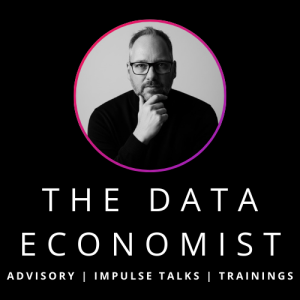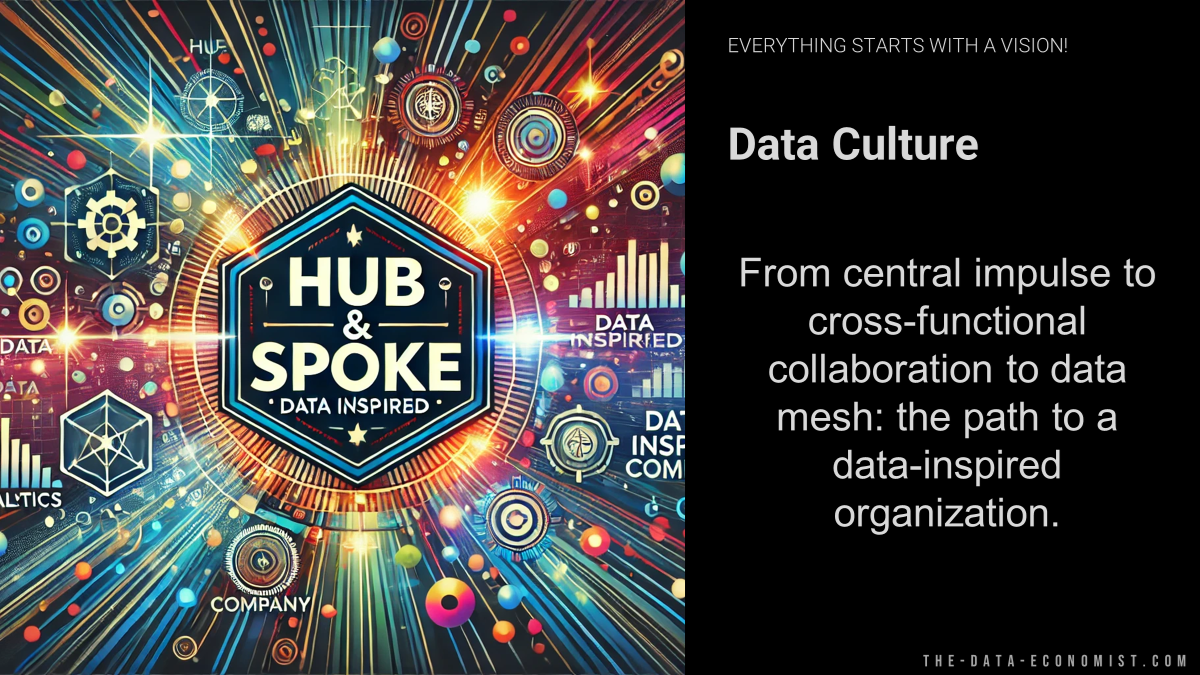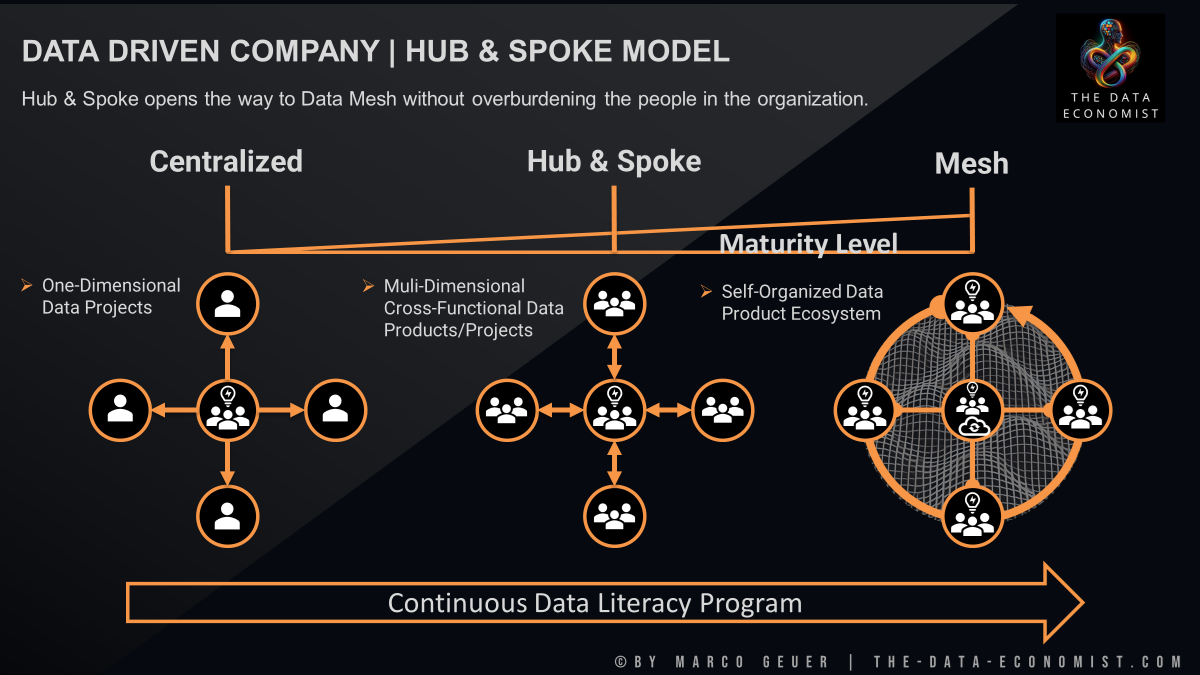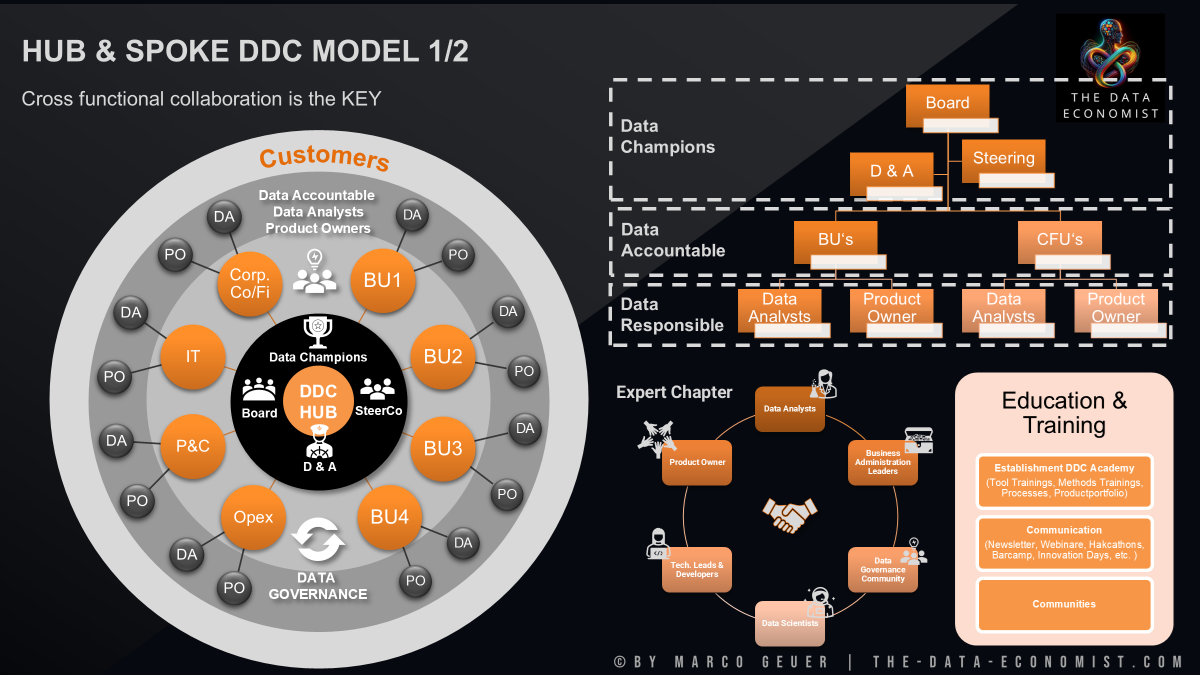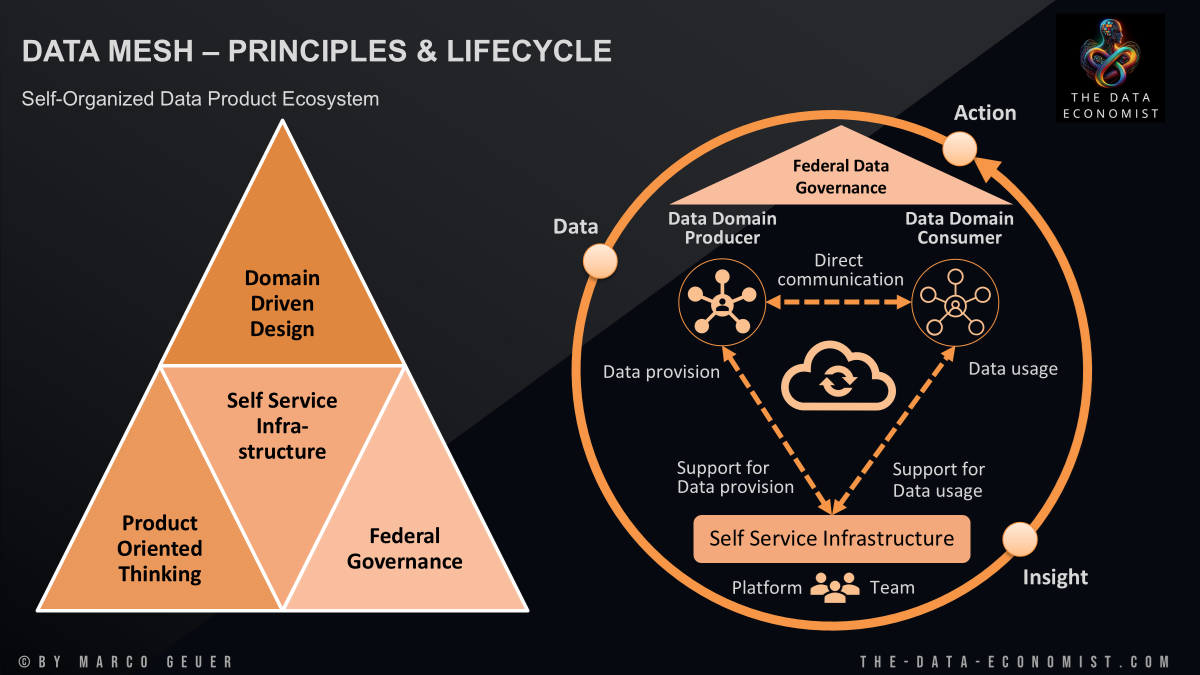The Hub & Spoke Model: A Roadmap to a Data-Inspired Organization
Why the hub & spoke model is a good idea to transform an organization into a data-inspired culture.
In the digital transformation, data management is becoming increasingly important as a prerequisite for the successful use of data analytics and AI. But how does an organization become truly “data inspired”? A promising approach is the Hub & Spoke Model, which helps companies to act in a data-inspired way while gradually developing the maturity of the organization without overwhelming people and organization. In this article, I will discuss how the Hub & Spoke Model can help you become a Data Inspired Company and how it can support you on your way to becoming a cross-functional and agile data-inspired organization.
1. Starting point: The central impulse – the hub as the initial engine
The path to becoming a data-inspired company begins at the center – the hub. This central point acts as the starting point and initiator for all data-related initiatives. Expert knowledge, data expertise and strategic decisions are bundled here. The hub is the basis for all further steps and ensures that data initiatives are developed in a coherent and targeted manner.
A solid data infrastructure is built in the hub, which sets the framework for data-inspired transformation. The focus is on establishing central data sources, ensuring data quality and making initial data-driven decisions. This central impetus creates the necessary basis for the next phase – expansion into the organization.
2. Evolution: cross-functional teams as spokes
Once the hub is established, the next step is to expand across the organization. This is where the so-called “spokes” come into play. These cross-functional teams represent the various business units and act as spokes connected to the hub.
In this phase, the foundation for a comprehensive data culture is laid. The spokes act as ambassadors for the hub knowledge, adapt data-driven approaches to their specific needs and drive innovative projects. A central aspect of this phase is the joint development of the first data products. Cross-functional teams work together to create data products that generate immediate value for the organization and its customers. The customer is involved in the development process at an early stage to ensure that the solutions are tailored and market-oriented. These data products are continuously developed to reflect the changing needs of customers and the market.
The advantage of this model lies in its flexibility: each department can develop its data-driven initiatives while simultaneously benefiting from the central expertise of the hub. Furthermore, it ensures that the initiatives are derived in a complementary way from the company-wide Data & AI Strategy. The iterative process of developing and improving data products strengthens innovation and creates shared value that can be felt both internally and externally.
3. The next level of maturity: from a spoke to a data mesh
To become a truly data-inspired organization, it is necessary to further decentralize data expertise. This is achieved by transforming from a spoke model to a data mesh. In a data mesh, data is no longer managed centrally, but is developed and maintained by the respective domains themselves. Each domain acts autonomously and develops its own data products, which benefit the entire organization and its customers.
The data mesh promotes personal responsibility and innovation within the organization. It enables teams to work independently and agilely, while ensuring that data and data products can be used across the board. This significantly increases the organization's maturity in terms of data handling and paves the way for even more profound data-inspired innovation.
4. Maturity-oriented development: Challenging without overwhelming
The development towards a data-inspired company requires a delicate balance between challenging progress and overwhelming employees. The hub-and-spoke model allows the organization to develop incrementally while taking into account the respective maturity. It challenges people to continuously expand their data literacy without overburdening them.
A comprehensive data literacy program plays a central role in this. This program supports the organization throughout the entire development process and ensures that employees receive continuous training and are empowered to deal with the new data-driven requirements. The data literacy program not only promotes an understanding of data and its use, but also creates a culture of continuous learning and adaptation. This systematically advances the organization's maturity level and empowers employees to become active shapers of the data-driven transformation.
Each phase of the model offers clear benefits and prepares the organization for the next level of maturity. By matching the pace of transformation to the respective maturity level and supporting employee development through targeted training programs, companies can ensure that the changes are sustainable and supported by the entire organization.
Conclusion
The hub-and-spoke model is more than just a method; it is a holistic approach that helps companies become data-inspired organizations. By introducing and developing data expertise in stages, supported by a robust data literacy program, it enables a sustainable transformation that meets both current and future requirements. Companies that embark on this journey are laying the foundation for an innovative, data-inspired future.
Summary
The hub & spoke model offers several advantages for companies that want to become a “data-inspired company”. Here are the main advantages, along with a brief explanation:
- Central starting point and coherence (hub):
- Advantage: The hub serves as a central starting point where data strategies are developed and managed. It combines expertise, data skills and infrastructure.
- Explanation: This enables a coherent and targeted introduction of data initiatives, ensuring that all activities are aligned with the corporate strategy and that synergies are exploited.
- Flexibility and adaptability (spokes):
- Advantage: The spokes represent various departments or teams that are closely linked to the hub but can also develop their own data-inspired initiatives.
- Explanation: This structure fosters flexibility by allowing teams to develop specific solutions tailored to their needs while still benefiting from the central expertise of the hub.
- Cross-functional collaboration and innovation:
- Advantage: Cross-functional teams, acting as spokes, work together to develop innovative data products that create real value for the organization and its customers.
- Explanation: This collaboration promotes the integration of different perspectives and expertise, which increases the quality and relevance of the data products developed.
- Step-by-step maturity development:
- Advantage: The hub-and-spoke model allows for a step-by-step transformation of the organization that is adapted to the respective level of maturity.
- Explanation: This ensures that the organization and its employees are not overwhelmed but can develop continuously. This promotes a sustainable transformation.
- Promoting ownership and agility (transition to the data mesh):
- Advantage: The transition from the spoke model to the data mesh promotes autonomy and innovation within the organization.
- Explanation: Domains take responsibility for their data and independently develop data products that can be used by the entire organization, increasing efficiency and agility.
- Continuous development of data literacy:
- Advantage: An accompanying data literacy program promotes the continuous development of data literacy throughout the organization.
- Explanation: This ensures that employees are empowered to meet data-inspired requirements, which increases the acceptance and success of the transformation.
By combining these advantages, the hub-and-spoke model offers a well-thought-out and practical strategy for gradually and sustainably leading companies into a data-inspired future.
Transformation to a data-inspired organization using the hub-and-spoke model in pictures
More articles on related topics:
Data Strategy, Data Literacy, Data Driven Company, Data Mesh, Data Culture, Data Driven, Data & AI Strategy, Hub & Spoke Model, Modern Data Organization
- Geändert am .
- Aufrufe: 28740
